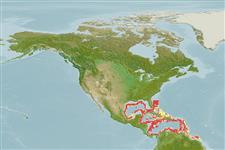Elasmobranchii (tubarões e raias) (sharks and rays) >
Carcharhiniformes (Ground sharks) >
Pentanchidae (Deepwater catsharks)
Etymology: Apristurus: a-, Latin privative, i.e., without; pristis, from pristes (Gr.), sawyer (but here meaning saw); oura (Gr.), tail, referring to absence of saw-toothed crest of enlarged dermal denticles along upper edge of caudal fin as found in the closely related Pristiurus (=Galeus) (See ETYFish); parvipinnis: parvus (L.), small; pinnis (L.), fin, referring to first dorsal fin 2-4 times smaller than second dorsal fin (See ETYFish).
Environment: milieu / Zona climática / intervalo de profundidade / distribution range
Ecologia
marinhas batidemersal; intervalo de profundidade 600 - 1380 m (Ref. 44037). Deep-water; 30°N - 6°N
Western Atlantic: northeastern Gulf of Mexico off Florida, Gulf of Campeche, Panama, Colombia, and off French Guiana. Had been originally termed Apristurus indicus by Springer (1966) but apparently not conspecific with the Indian Ocean species.
Tamanho / Peso / Idade
Maturidade: Lm ? range ? - ? cm
Max length : 48.0 cm TL macho/indeterminado; (Ref. 244); 52.0 cm TL (female)
Second dorsal fin distinctly larger than the first (Ref. 13608).
Body shape (shape guide): elongated.
Found on the continental slope. Oviparous, apparently laying one egg per oviduct at a time. The most common Apristurus species in the Gulf of Mexico, along with A. laurussonii.
Ciclo de vida ou comportamento de acasalamento
Maturidade | Reprodução | Desova | Ovos | Fecundidade | Larvas
Oviparous, paired eggs are laid. Embryos feed solely on yolk (Ref. 50449).
Compagno, L.J.V., 1984. FAO Species Catalogue. Vol. 4. Sharks of the world. An annotated and illustrated catalogue of shark species known to date. Part 2 - Carcharhiniformes. FAO Fish. Synop. 125(4/2):251-655. Rome: FAO. (Ref. 244)
Status na Lista Vermelha da UICN (Ref. 130435: Version 2025-1)
Ameaça para os humanos
Harmless
Uso pelos humanos
Pescarias: pesca de subsistência
Ferramentas
Relatórios especiais
Baixar XML
Fontes da internet
Estimates based on models
Preferred temperature (Ref.
123201): 5.2 - 10.4, mean 6.4 °C (based on 83 cells).
Índice de diversidade filogenética (Ref.
82804): PD
50 = 0.5000 [Uniqueness, from 0.5 = low to 2.0 = high].
Bayesian length-weight: a=0.00355 (0.00175 - 0.00721), b=3.08 (2.90 - 3.26), in cm total length, based on LWR estimates for this (Sub)family-body shape (Ref.
93245).
Nível Trófico (Ref.
69278): 3.9 ±0.6 se; based on size and trophs of closest relatives
Resiliência (Ref.
120179): Muito baixo(a), tempo mínimo de duplicação da população maior que 14 anos (Fec assumed to be <10).
Fishing Vulnerability (Ref.
59153): Moderate vulnerability (41 of 100).
🛈
